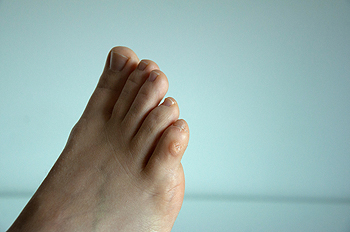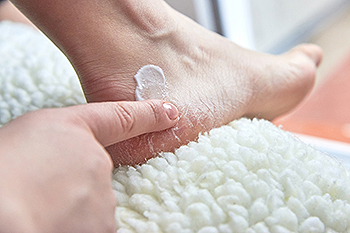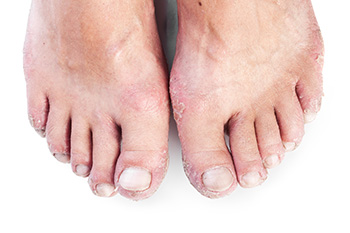Connect With Us
Blog
Items filtered by date: February 2023
Where Are Corns Located?

Corns are a condition of the feet that is primarily defined by hard layers of skin that develop in response to friction. Corns, importantly, are distinct from calluses. Many patients and novices to the field of podiatry often wonder where, exactly, corns can develop on the feet. The answer is slightly complicated. Corns are most commonly located on the soles, or bottoms, of the feet. However, they can also be found elsewhere on the feet. For example, corns can also be found on bony parts of the foot. This is to say that corns can be located on the toes, especially around the joints. You might also be most susceptible to developing corns wherever the skin is particularly thin. If you are someone that is concerned about developing corns on your feet, it is suggested that you contact a podiatrist today for more information. Schedule an appointment today.
If you have any concerns regarding your feet and ankles, contact Julie Jurd-Sadler, DPM of Progressive Podiatry. Our doctor will treat your foot and ankle needs.
Corns: What Are They? and How Do You Get Rid of Them?
Corns can be described as areas of the skin that have thickened to the point of becoming painful or irritating. They are often layers and layers of the skin that have become dry and rough, and are normally smaller than calluses.
Ways to Prevent Corns
There are many ways to get rid of painful corns such as wearing:
- Well-fitting socks
- Comfortable shoes that are not tight around your foot
- Shoes that offer support
Treating Corns
Treatment of corns involves removing the dead skin that has built up in the specific area of the foot. Consult with Our doctor to determine the best treatment option for your case of corns.
If you have any questions please feel free to contact our offices located in Ijamsville and Mouth Airy, MD . We offer the newest diagnostic and treatment technologies for all your foot and ankle needs.
Relief for Cracked Heels

Cracked heels are a common foot condition that can cause embarrassment from being unsightly. They can happen from excess pressure that is put on the heels, which can occur from standing on hard surfaces for most of the day. Additionally, wearing shoes that have an open back can cause the skin to become dry, possibly leading to getting cracked heels. There may be specific medical conditions that can contribute to developing cracked heels. These can include eczema, psoriasis, and fungal infections. Many people can have this condition from vitamin deficiencies, which can affect skin health. Relief tactics can begin with washing and drying the feet, followed by applying a good moisturizer on them. Many people have found it to be successful to increase their water intake, which can help the skin from becoming dry. If you have cracked heels, it is strongly advised that you are under the care of a podiatrist who can offer you the correct treatment remedies, which may include prescribed medicine.
If the skin on your feet starts to crack, you may want to see a podiatrist to find treatment. If you have any concerns, contact Julie Jurd-Sadler, DPM from Progressive Podiatry. Our doctor can provide the care you need to keep you pain-free and on your feet.
Cracked Heels
It is important to moisturize your cracked heels in order to prevent pain, bleeding, and infection. The reason cracked heels form is because the skin on the foot is too dry to support the immense pressure placed on them. When the foot expands, the dry skin on the foot begins to split.
Ways to Help Heal Them
- Invest in a good foot cream
- Try Using Petroleum Jelly
- Ease up on Soaps
- Drink Plenty of Water
Ways to Prevent Cracked Heels
- Moisturize After Showering
- Skip a Shower
- Keep Shower Water Lukewarm
- Don’t Scrub Your Feet
If you are unsure how to proceed in treating cracked heels, seek guidance from a podiatrist. Your doctor will help you with any questions or information you may need.
If you have any questions, please feel free to contact our offices located in Ijamsville and Mouth Airy, MD . We offer the newest diagnostic and treatment technologies for all your foot care needs.
Psoriatic Arthritis and the Feet

Psoriatic arthritis often occurs with people who have already been diagnosed with psoriasis, a disease that produces a skin rash, typically on the scalp and hands. But many of those affected also experience pain in the feet and Achilles tendon. This is known as enthesitis, a condition that causes inflammation of the tendons and ligaments that connect to bones. Symptoms include pain, swelling, and redness. Diagnosing psoriatic arthritis in the feet is not a straightforward process, as it may develop before the symptoms of psoriasis appear. Treatment options include non-steroidal anti-inflammatory medications of varying strength, depending on the severity of the disease. Seeing a podiatrist is a good idea, so that a complete examination and diagnosis can be made. A podiatrist can also offer other lifestyle and footwear changes that may help to reduce the effects of psoriatic arthritis in the feet and ankles.
Arthritis can be a difficult condition to live with. If you are seeking treatment, contact Julie Jurd-Sadler, DPM from Progressive Podiatry. Our doctor can provide the care you need to keep you pain-free and on your feet.
Arthritic Foot Care
Arthritis is a joint disorder that involves the inflammation of different joints in your body, such as those in your feet. Arthritis is often caused by a degenerative joint disease and causes mild to severe pain in all affected areas. In addition to this, swelling and stiffness in the affected joints can also be a common symptom of arthritis.
In many cases, wearing ill-fitting shoes can worsen the effects and pain of arthritis. Wearing shoes that have a lower heel and extra room can help your feet feel more comfortable. In cases of rheumatoid arthritis, the arch in your foot may become problematic. Buying shoes with proper arch support that contour to your feet can help immensely.
Alleviating Arthritic Pain
- Exercises that stretch the foot can prevent further pain and injury and increase mobility
- Most of the pain can be alleviated with anti-inflammatory drugs, heat, and topical medications
- Massages can help temporarily alleviate pain.
It is best to see your doctor for the treatment that is right for your needs and symptoms. Conditions vary, and a podiatrist can help you determine the right method of care for your feet.
If you have any questions, please feel free to contact our offices located in Ijamsville and Mouth Airy, MD . We offer the newest diagnostic tools and technology to treat your foot and ankle needs.
Possible Causes of Ankle Pain in Runners

The average runner takes 1,700 steps per mile. Not surprisingly, runners often experience ankle pain. The first thing to do when your ankle hurts, according to experts, is to stop the activity, as continuing to run may make the injury worse. The most common causes of ankle pain include sprains and strains, stress fractures, and tendonitis. A sprained ankle occurs when the ligament in the ankle joint is stretched past its limit. A strained ankle occurs when a muscle or tendon in the joint is similarly overstretched. Stress fractures are tiny, hairline cracks in the bone, usually the result of overuse, such as increasing mileage or intensity too quickly. Tendonitis is the inflammation of a tendon, and the ankle contains a number of them. The most common source of tendonitis is the Achilles tendon in the back of the heel. If you are experiencing ankle pain that impedes your ability to run, please consult a podiatrist who can examine the ankle, determine the cause, and offer treatment options.
Ankle pain can have many different causes and the pain may potentially be serious. If you have ankle pain, consult with Julie Jurd-Sadler, DPM from Progressive Podiatry. Our doctor will assess your condition and provide you with quality foot and ankle treatment.
Ankle pain is any condition that causes pain in the ankle. Due to the fact that the ankle consists of tendons, muscles, bones, and ligaments, ankle pain can come from a number of different conditions.
Causes
The most common causes of ankle pain include:
- Types of arthritis (rheumatoid, osteoarthritis, and gout)
- Ankle sprains
- Broken ankles
- Achilles tendinitis
- Achilles tendon rupture
- Stress fractures
- Tarsal tunnel syndrome
- Plantar fasciitis
Symptoms
Symptoms of ankle injury vary based upon the condition. Pain may include general pain and discomfort, swelling, aching, redness, bruising, burning or stabbing sensations, and/or loss of sensation.
Diagnosis
Due to the wide variety of potential causes of ankle pain, podiatrists will utilize a number of different methods to properly diagnose ankle pain. This can include asking for personal and family medical histories and of any recent injuries. Further diagnosis may include sensation tests, a physical examination, and potentially x-rays or other imaging tests.
Treatment
Just as the range of causes varies widely, so do treatments. Some more common treatments are rest, ice packs, keeping pressure off the foot, orthotics and braces, medication for inflammation and pain, and surgery.
If you have any questions, please feel free to contact our offices located in Ijamsville and Mouth Airy, MD . We offer the newest diagnostic and treatment technologies for all your foot care needs.
Blog Archives
- April 2025
- March 2025
- February 2025
- January 2025
- December 2024
- November 2024
- October 2024
- September 2024
- August 2024
- July 2024
- June 2024
- May 2024
- April 2024
- March 2024
- February 2024
- January 2024
- December 2023
- November 2023
- October 2023
- September 2023
- August 2023
- July 2023
- June 2023
- May 2023
- April 2023
- March 2023
- February 2023
- January 2023
- December 2022
- November 2022
- October 2022
- September 2022
- August 2022
- July 2022
- June 2022
- May 2022
- April 2022
- March 2022
- February 2022
- January 2022
- December 2021
- November 2021
- October 2021
- September 2021
- August 2021
- July 2021
- June 2021
- May 2021
- April 2021
- March 2021
- February 2021
- January 2021
- December 2020
- November 2020
- October 2020
- September 2020
- August 2020
- July 2020
- June 2020
- May 2020
- April 2020
- March 2020
- February 2020
- January 2020
- December 2019
- November 2019

